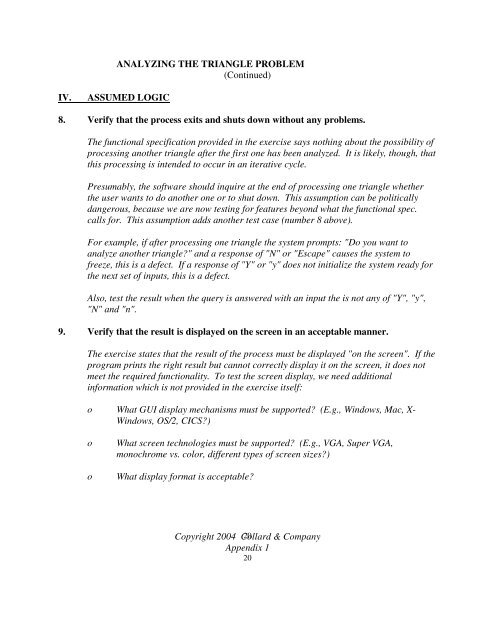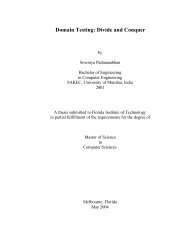appendix 1. analyzing the triangle problem - Testing Education
appendix 1. analyzing the triangle problem - Testing Education
appendix 1. analyzing the triangle problem - Testing Education
Create successful ePaper yourself
Turn your PDF publications into a flip-book with our unique Google optimized e-Paper software.
IV. ASSUMED LOGIC<br />
ANALYZING THE TRIANGLE PROBLEM<br />
(Continued)<br />
8. Verify that <strong>the</strong> process exits and shuts down without any <strong>problem</strong>s.<br />
The functional specification provided in <strong>the</strong> exercise says nothing about <strong>the</strong> possibility of<br />
processing ano<strong>the</strong>r <strong>triangle</strong> after <strong>the</strong> first one has been analyzed. It is likely, though, that<br />
this processing is intended to occur in an iterative cycle.<br />
Presumably, <strong>the</strong> software should inquire at <strong>the</strong> end of processing one <strong>triangle</strong> whe<strong>the</strong>r<br />
<strong>the</strong> user wants to do ano<strong>the</strong>r one or to shut down. This assumption can be politically<br />
dangerous, because we are now testing for features beyond what <strong>the</strong> functional spec.<br />
calls for. This assumption adds ano<strong>the</strong>r test case (number 8 above).<br />
For example, if after processing one <strong>triangle</strong> <strong>the</strong> system prompts: "Do you want to<br />
analyze ano<strong>the</strong>r <strong>triangle</strong>?" and a response of "N" or "Escape" causes <strong>the</strong> system to<br />
freeze, this is a defect. If a response of "Y" or "y" does not initialize <strong>the</strong> system ready for<br />
<strong>the</strong> next set of inputs, this is a defect.<br />
Also, test <strong>the</strong> result when <strong>the</strong> query is answered with an input <strong>the</strong> is not any of "Y", "y",<br />
"N" and "n".<br />
9. Verify that <strong>the</strong> result is displayed on <strong>the</strong> screen in an acceptable manner.<br />
The exercise states that <strong>the</strong> result of <strong>the</strong> process must be displayed "on <strong>the</strong> screen". If <strong>the</strong><br />
program prints <strong>the</strong> right result but cannot correctly display it on <strong>the</strong> screen, it does not<br />
meet <strong>the</strong> required functionality. To test <strong>the</strong> screen display, we need additional<br />
information which is not provided in <strong>the</strong> exercise itself:<br />
o What GUI display mechanisms must be supported? (E.g., Windows, Mac, X-<br />
Windows, OS/2, CICS?)<br />
o What screen technologies must be supported? (E.g., VGA, Super VGA,<br />
monochrome vs. color, different types of screen sizes?)<br />
o What display format is acceptable?<br />
Copyright 2004 Collard 20 & Company<br />
Appendix 1<br />
20








